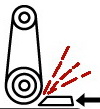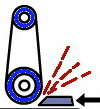A fabricator can enjoy more than labor savings by installing deburring, deslagging and edge rounding equipment
New technology in the fabrication industry has given the metal fabricator more options to produce parts for their customers. Fiber laser cutting machines, in particular, allow the fabricator to cut more parts in a day than it ever could with CO2 lasers. Automated load and unload systems attached to these laser cutting machines also allow the shop to cut almost 24/7. Punching machines, Stamping lines, fine blanking lines gives even bigger output of parts to be deburred.
While fabricators can cut parts more quickly than ever before, they have to deal with other bottlenecks downstream from the laser or press. Depending on the cut quality or customer requirement, they might need to deburr, edge-round, or remove the oxide layer on a part. To stay competitive and get parts out of the shop in a timely fashion, fabricators should look at automating the deburring process just as they did with the laser cutting process.
Adding more bodies to the deburring department has been the traditional way of attacking the deburring issue. However, increased labor costs, lack of efficiency, lack of consistency, and the need to provide a safer working environment have led companies to search for a different solution—automated deburring.
The case for an automated deburring machine makes sense for a modern metal fabricating environment. Management realizes true labor savings. Shop floor morale picks up as people are freed from the hard and monotonous work of manually grinding edges. Older workers are less likely to hurt themselves doing this taxing work. Customers receive parts that are consistent and in the best shape to be painted or powder coated. It’s hard to overlook all of the benefits when they are clearly presented.
Calculating the Costs of Manual Deburring
Even with all the advanced technology on today’s automated laser equipment, a machine that is not dialed in correctly can lead to a sheet full of parts with burrs to remove. What do you do with all the parts with burrs? Scrap them, or deburr them? Pull workers from other machines to deburr and delay their jobs?
When companies look at the economics of their current method of manual deburring, many of them aren’t aware of the true costs associated with their process. Sometimes they are surprised by the total processing costs in the deburring department. For instance, if a fabricator has two shifts of four people manually deburring, it could find its costs associated with deburring to be more than 300.000 Euro per year. With a machine for deburring the parts’ tops and bottoms in one pass, the fabricator could see a dramatic reduction of workers, possibly the elimination of a shift that was once dedicated to deburring; in fact, it would need only two people to load and unload the parts on the automated deburring machine. Those labor savings could help that fabricator pay off its new automated deburring machine in a year or less.
Understanding the total processing costs associated with manual deburring can be beneficial, but there are other overlooked benefits fabricators should consider with automating the deburring department.
Keeping Workers Safe
Fabricators surely have noticed that manufacturing workers are getting older.
As fabricators struggle to find workers for their open positions, experienced workers become that much more valuable. Unfortunately, these older workers do not have the same physical traits as their younger counterparts.
Automated deburring and edge rounding equipment can help a fabricator reduce employees’ fatigue levels by making the deburring job easier than manual deburring. With automated deburring machines, employees are asked to move laser-cut parts from the skeleton to the conveyor feeding the deburring equipment. The operator doesn’t have to worry about the manual adjustment of tools or sand blocks. Machines with wear compensation give consistent edge rounding as they measure wear.
The use of motorized straight-line or return conveyors allows for more efficiency and reduces the operator’s movement and lifting. The footprint of an automated deburring machine or the machine and accompanying conveyors is relatively small, especially when compared to the layout of a laser cutting machine. This type of cell setup keeps older workers productive and on the job longer, when their presence has never been more valued.
Delivering Consistent Parts
Parts producers know their reputation is on the line for quality, on-time deliveries. Automated deburring reduces the potential risk for costly rejected parts.
There is a big difference between two shifts of manual grinders and their understanding of what a “deburred part” is compared to a machine with set parameters and repeatability. Deburring can be very subjective. Simply put, there are too many human factors to get in the way. Having a machine to maintain the deburring spec produces better and more consistent parts.
A shop could have highly skilled workers manually grinding laser-cut parts to increase the chance of consistent burr removal and acceptable edge rounding, but the reality is that fabricators rarely put their most experienced workers on these jobs. Their value is elsewhere in the shop, in front of the press brake or welding. That leaves the job to inexperienced workers. One grinder who processes a part that he thinks is good enough doesn’t remove all of the burrs, and another grinder next to him goes the extra mile and does too much. Now that fabricator has a pallet filled with three different stacks of “quality” parts.
The risk of returned parts is always there, but faulty parts that escape quality control and make their way into final end product fabrications could become a huge pain for the entire supply chain.
An automated deburring and edge rounding machine is able to deliver a part that has a consistent finish each time a part is sent through. Fabricators can work with customers to determine just what finish is desired, and once the machine has been dialed in to deliver that agreed-upon specification, the program can be saved and used for jobs in the future. The customer can expect to receive the same deburred and edge-rounded part it got six months previously.
These automated deburring machines also have sensor technology incorporated that notify the operator when deburring belts and blocks need to be replaced. This ensures that consumables are always in the best shape to deliver quality and consistent parts.
Promoting Better Paint/Powder Adhesion on Steel Parts
Many fabricators cutting with a CO2 or fiber laser or plasma cutter use oxygen as an assist gas. As a result, they have to deal with removal of the laser oxide or burned edge from the part. The oxide layer that is created on the laser-cut edge of the parts and on the edges of internal cutouts is a barrier for paint adhesion, preventing the paint from sticking to the bare metal. The paint actually will stick to the oxide layer and will peel away from the part, exposing bare metal to the environment, which can lead to premature rust.
To avoid the oxide layer issues in cutting, fabricators can cut with nitrogen as an assist gas or use oxygen as an assist gas and later media-blast the parts. The blasting removes oxide from the edge, but it does not round the top and bottom edges of the part. (Only a small amount of paint will adhere to the top and bottom edges if the edges are not rounded.) An automated deburring machine addresses the oxide layer removal and the edge rounding.
Edge rounding has been found to help paint and powder coatings stick to the part and prevent corrosion down the road. Quite simply, rounding the top and bottom edges creates a flatter surface area for paint to adhere compared to a sharp, 90-degree edge where little paint can stick to the edges.
Salt spray testing reveals that companies painting or powder coating parts need both laser oxide removal and rounded edges to achieve the best-case scenario for paint adhesion. When doing these two processes, a fabricator can see its painted or powder coated parts last more than 1,000 hours in a salt spray chamber without paint adhesion concerns.


